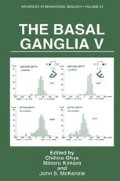Abstract
In recent years, the development of primate models of Parkinson’s disease has made it possible to clarify some of the pathophysiological mechanisms underlying parkinsonian symptoms (akinesia, rigidity, tremor and dopa-induced dyskinesia=DID)(Crossman, 1987). A sophisticated functional architecture of basal ganglia circuits has been proposed(Alexander and Crutcher, 11990), and parkinsonian symptoms can be accounted for by postulating specific disturbances within the basal ganglia-thalamocortical motor circuit(DeLong,1990). Lesion experiments in monkeys have revealed that parkinsonian-like tremor was the result of damage to the nigrostriatal dopaminergic pathways in combination with damage to the rubro-olivo-cere-bello-rubral and cerebello-thalamic pathways(Larochelle et al., 1970). Based on experimental studies in monkeys and depth microelectrode studies in the human thalamus, a closed tremor-mediating neuronal circuit has been proposed(Ohye, 1988a; Ohye et al., 1993). However, the data in living humans remain inconsistent. We have recorded spontaneous neuronal activity in the thalamus or pallidum with the aid of microelectrodes during the course of stereotactic thalamotomy or pallidotomy, clarifying several characteristic features in Parkinson’s disease(Ohye et al., 1979, 1989). On the other hand, positron emission tomography(PET) allows measurements of regional cerebral glucose metabolism(rCMRGlu)(Sokoloff et al., 1977; Phelps et al., 1979) and cerebral blood flow(rCBF) (Frackowiak et al., 1980), which is related to the local functional activity of the central nervous system(Sokoloff, 1981). Combining both independent techniques, we have studied the neural mechanisms or on-going changes underlying movement disorders of Parkinson’s disease(Ohye et al., 1991; Hirato et al., 1991, 1993). The present study was conducted to elucidate the possible neural pathway mediating parkinsonian symptoms in human beings.
Access this chapter
Tax calculation will be finalised at checkout
Purchases are for personal use only
Preview
Unable to display preview. Download preview PDF.
References
Alexander, G.E. and Crutcher, M.D., 1990, Functional architecture of basal ganglia circuits: neural substrates of parallel processing, Trends. Neurosci. 13:266–271.
Crossman, A.R., 1987, Primate models of dyskinesia: The experimental approach to the study of basal ganglia-related involuntary movement disorders, Neuroscience 21:1–40.
DeLong, M.R., 1990, Primate models of movement disorders of basal ganglia origin, Trend. Neurosci. 13:281–285.
Filion, M., Tremblay, L., and Bedard, P.J., 1988, Abnormal influences of passive limb movement on the activity of globus pallidus neurons in parkinsonian monkeys. Brain Res. 444:165–176.
Frackowiak, R.S.J., Lenzi, G.L., Jones, T. and Heather, J.D., 1980, Quantitative measurement of regional cerebral blood flow and oxygen metabolism in man using 150 and positron emission tomography: Theory, procedure, and normal values, J. Comput. Assist. Tomogr. 4:727–736.
Hirato, M., Satake, K., Horikoshi, S., Kawashima, Y., Shibasaki, T. and Ohye, C., 1991, Characteristics of regional cerebral metabolism in cases with tremor-PET study-(Japanese), Fund. Neurosurg. 30:93–102.
Hirato, M., Horikoshi, S., Kawashima, Y., Satake, K., Shibazaki, T. and Ohye, C., 1993, Different cerebral metabolism between parkinsonian rigidity and hyperkinesia (DID, Chorea, Dystonia)-A PET study, Adv.Neurol. 60:511–514.
Hoover J.E. and Strick PL., 1993, Multiple output channels in the basal ganglia, Science 259:819–821.
Lamarre, Y., and Joffroy, A.J., 1979, Experimental tremor in monkey: activity of thalamic and precentrai cortical neurons in the absence of peripheral feedback. Adv. Neurol. 24:109–122.
Larochelle, L., Bedard, P., Boucher, R., and Poirier, L.J., 1970, The rubro-olivo-cerebello-rubral loop and postural tremor in the monkey. J. Neurol. Sci. 11:53–64.
Mitchell, I.J., Clarke, C.E., Boyce, S., Robertson, R.G., Peggs, D., Sambrook, M.A. and Crossman, A.R., 1989, Neural mechanisms underlying Parkinsonian symptoms based upon regional uptake of 2-deoxyglucose in monkeys exposed to 1-methyl-4-phenyl-1,2,3,6-tetrahydropyridine, Neuroscience 32:213–226.
Ohye, C., 1988a, Studies on experimental tremor (Japanese), in: Handbook of Physiology (Sasaki, K., Hongo, T. eds.), vol 10, Igaku-shoin, Tokyo, pp. 243–258.
Ohye, C., 1988b, Selective thalamotomy for movement disorders: microrecording stimulation techniques and results, in Modern Stereotactic Neurosurgery (Lunsford, L.D. ed.), Martinus Nijhoff, Boston, pp. 315–331.
Ohye, C., and Narabayashi, H., 1979, Physiological study of presumed ventralis intermedius neurons in the human thalamus. J. Neurosurg. 50:290–297.
Ohye, C., Shibazaki, T., Hirai, T., Wada, H., Hirato, M., and Kawashima, Y., 1989, Further physiological observations on the ventralis intermedius neurons in the human thalamus. J. Neurophysiol. 61:488–500.
Ohye, C., Shibazaki, T., Hirato, M., Kawashima, Y., Matsumura, M. and Shibazaki, T., 1991, Neural activity of the basal ganglia in Parkinson’s disease studied by depth recording and PET scan, in: Basal Ganglia 3, (G. Bernardi, M.B. Carpenter, G. Di Chiara, M. Morelli, P. Stanzione, eds.), Plenum Press, New York, pp. 637–644.
Ohye, C., Shibazaki, T., Hirai, T., Kawashima Y., Hirato, M., and Matsumura, M., 1993, Tremor-mediating thalamic zone studied in humans and in monkeys, Stereotact. Funct. Neurosurg. 60:136–145.
Phelps, M.E., Huang, S.C., Hoffman, E.J., Selin, C., Sokoloff, L. and Kuhl, D.E, 1979, Tomographic measurement of local cerebral glucose metabolic rate in humans with (F-18)-2-fluoro-2-deoxy-D-glucose: Validation of method, Ann. Neurol. 6:371–388.
Roland, P.E., Larsen, B., Lassen, N.A., and Shinhoj, E., 1980, Supplementary motor area and other cortical areas in organization of voluntary movements in man. J. Neurophysiol. 43:118–136.
Schwartz, W.J., Smith, C.B., Davidsen, L., Savaki, H., Sokoloff, L., Mata, M., Fink, D.J., and Gainer, H., Metabolic mapping of functional activity in the hypothalamo-neurohypophysial system of the rat. Science 205:723–725.
Sokoloff, L., 1981, Relationships among local functional activity, energy metabolism, and blood flow in the central nervous system. Fed. Proc. 40:2311–2316.
Sokoloff, L., Reivich, M., Kennedy, C., Des Rosiers, M.H., Patlak, C.S., Pettigrew, K.D., Sakurada, O., and Shinohara, M., 1977, The (14C)-deoxyglucose method for the measurement of local cerebral glucose utilization: Theory, procedure, and normal values in the conscious and anesthetized albino rat, J. Neurochem. 28:897–916.
Author information
Authors and Affiliations
Editor information
Editors and Affiliations
Rights and permissions
Copyright information
© 1996 Springer Science+Business Media New York
About this chapter
Cite this chapter
Hirato, M. et al. (1996). Dynamic Studies on the Possible Neural Pathway Mediating Parkinsonian Symptoms (Tremor, Rigidity and Did) Using Pet Scan and Microrecording. In: Ohye, C., Kimura, M., McKenzie, J.S. (eds) The Basal Ganglia V. Advances in Behavioral Biology, vol 47. Springer, Boston, MA. https://doi.org/10.1007/978-1-4899-0194-1_30
Download citation
DOI: https://doi.org/10.1007/978-1-4899-0194-1_30
Publisher Name: Springer, Boston, MA
Print ISBN: 978-1-4899-0196-5
Online ISBN: 978-1-4899-0194-1
eBook Packages: Springer Book Archive

